CoVaR
Tobias Adriany
Federal Reserve Bank of New Yorkz
Markus K. Brunnermeierx
Princeton University
This Version: November 1, 2010
Abstract
We propose a measure for systemic risk: CoVaR, the value at risk (VaR) of the
nancial system conditional on institutions being under distress. We dene an insti-
tutions contribution to systemic risk as the di⁄erence between CoVaR conditional
on the institution being under distress and the CoVaR in the median state of the
institution. From our estimates of CoVaR for the universe of publicly traded nan-
cial institutions, we quantify the extent to which characteristics such as leverage,
size, and maturity mismatch predict systemic risk contribution. We show that pre-
dicted systemic risk contribution is countercyclical, and argue for macroprudential
regulation based on the degree to which such characteristics predict systemic risk
contribution.
Keywords: Value at Risk, Systemic Risk, Adverse Feedback Loop, Endogenous
Risk, Risk Spillovers, Financial Architecture, Capital Requirements
JEL classication: G01, G10, G18, G20, G28, G32, G38
Special thanks go to Daniel Green and Hoai-Luu Nguyen for outstanding research assistance. The
authors also thank Paolo Angelini, Gadi Barlevy, RenØ Carmona, Stephen Brown, Robert Engle, Mark
Flannery, Xavier Gabaix, Paul Glasserman, Beverly Hirtle, Jon Danielson, John Kambhu, Arvind Kr-
ishnamurthy, Burton Malkiel, Maureen OHara, Andrew Patton, Matt Pritsker, Matt Richardson, Jean-
Charles Rochet, JosØ Scheinkman, Jeremy Stein, Kevin Stiroh, and Skander Van den Heuvel for feedback,
as well as seminar participants at numerous universities, central banks, and conferences. We are grateful
for support from the Institute for Quantitative Investment Research Europe. Brunnermeier also acknowl-
edges nancial support from the Alfred P. Sloan Foundation. An earlier version of this paper with the
denition of CoVaR was presented at the NBER Summer Institute under the title Risk Spillovers of
Financial Institutionsin July 2008.
yFederal Reserve Bank of New York, Capital Markets, 33 Liberty Street, New York, NY 10045,
http://nyfedeconomists.org/adrian, e-mail: tobias.adrian@ny.frb.org.
zThe views expressed in this paper are those of the authors and do not necessarily represent those of
the Federal Reserve Bank of New York or the Federal Reserve System.
xPrinceton University, Department of Economics, Bendheim Center for Finance, Princeton, NJ 08540-
5296, NBER, CEPR, CESIfo, http://www.princeton.edu/~markus, e-mail: markus@princeton.edu.
�
1 Introduction
During times of nancial crises, losses tend to spread across nancial institutions, threat-
ening the nancial system as a whole.1 While comovement of nancial institutionsassets
and liabilities is primarily driven by fundamentals in normal times, comovement tends
to increase during times of crisis. Such increases of comovement give rise to systemic
risk the risk that institutional distress spreads widely and distorts the supply of credit
and capital to the real economy. Negative spillover e⁄ects can be direct, because of di-
rect contractual links and heightened counterparty credit risk, or indirect through price
e⁄ects via liquidity spirals. Measures of systemic risk that capture the increase in tail
comovement during nancial crises should become supervisory tools and form the basis
of any macroprudential regulation.
The most common measure of risk used by nancial institutions the value at risk
(VaR) focuses on the risk of an individual institution in isolation. The q%-VaR is
the maximum dollar loss within the q%-condence interval; see the overviews by Kupiec
(2002) and Jorion (2006). However, a single institutions risk measure does not necessarily
reect systemic risk the risk that the stability of the nancial system as a whole is
threatened. First, according to the classication in Brunnermeier, Crocket, Goodhart,
Perssaud, and Shin (2009), a systemic risk measure should identify the risk on the system
by individually systemic institutions, which are so interconnected and large that they
can cause negative risk spillover e⁄ects on others, as well as by institutions that are
systemic as part of a herd. A group of 100 institutions that act like clones can be as
precarious and dangerous to the system as the large merged identity. The S&L crisis in the
1980s is a prominent example of many small institutions being systemic as part of herd.
1Examples include the 1987 equity market crash, which was started by portfolio hedging of pension
funds and led to substantial losses of investment banks; the 1998 crisis, which was started with losses of
hedge funds and spilled over to the trading oors of commercial and investment banks; and the 2007-09
crisis, which spread from SIVs to commercial banks and on to investment banks and hedge funds. See
Brady (1988), Rubin, Greenspan, Levitt, and Born (1999), Brunnermeier (2009), and Adrian and Shin
(2010a).
1
�
Second, risk measures should recognize that risk typically builds up in the background in
the form of imbalances and bubbles and materializes only during a crisis. Hence, high-
frequency risk measures that rely primarily on contemporaneous price movements are
misleading and procyclical. Regulation based on such contemporaneous measures tends
to be procyclical and potentially amplies business cycles (see Adrian and Shin (2010b)).
The objective of this paper is twofold: First, we propose a measure for systemic risk.
Second, we outline a method that allows for a countercyclical implementation of macro-
prudential policy by predicting future systemic risk using current institutional character-
istics such as size, leverage, and maturity mismatch. To emphasize the systemic nature
of our risk measure, we add to existing risk measures the prex Co, which stands for
conditional, comovement, contagion, or contributing. We focus primarily on CoVaR,
where institution is CoVaR relative to the system is dened as the VaR of the whole
nancial sector conditional on institution i being in distress.2 The di⁄erence between
the CoVaR conditional on the distress of an institution and the CoVaR conditional on
the normal state of the institution, CoVaR, captures the marginal contribution of a
particular institution (in a non-causal sense) to the overall systemic risk.
There are several advantages to our CoVaR measure. First, while CoVaR focuses
on the contribution of each institution to overall system risk, current prudential regulation
focuses on the risk of individual institutions. Regulation based on the risk of institutions in
isolation can lead, in the aggregate, to excessive risk-taking along systemic risk dimensions.
To see this more explicitly, consider two institutions, A and B, which report the same VaR,
but for institution A the CoVaR= 0, while for institution B the CoVaR is large (in
absolute value). Based on their VaRs, both institutions appear equally risky. However,
the high CoVaR of institution B indicates that it contributes more to system risk. Since
2Just as VaR sounds like variance, CoVaR sounds like covariance. This analogy is no coincidence.
In fact, under many distributional assumptions (such as the assumption that shocks are conditionally
Gaussian), the VaR of an institution is indeed proportional to the variance of the institution, and the
CoVaR of an institution is proportional to the covariance of the nancial system and the individual
institution.
2
�
system risk might carry a higher risk premium, institution B might outshine institution
A in terms of generating returns, so that competitive pressure might force institution A
to follow suit. Imposing stricter regulatory requirements on institution B would break
this tendency to generate systemic risk.
One could argue that regulating institutionsVaR might be su¢ cient as long as each
institutions CoVaR goes hand in hand with its VaR. However, this is not the case, as
(i) it is not desirable that institution A should increase its contribution to systemic risk
by following a strategy similar to institution B and (ii) empirically, there is no one-to-one
connection between an institutions CoVaR (y-axis) and its VaR (x-axis), as Figure 1
shows. Overall, Figure 1 questions the usefulness of bank regulation to rely primarily on
VaR.
Figure 1: The scatter plot shows the weak link between institutions risk in isolation,
measured by VaRi (x-axis), and institutions contribution to system risk, measured by
CoVaRi (y-axis). The VaRi and CoVaRi are measured in 2006Q4 and are reported
in returns. A list with the names of the institutions corresponding to the tickers in this
plot is given in Appendix C.
Another advantage of our co-risk measure is that it is general enough to study the
risk spillovers across the whole nancial network. For example, CoVaRjji captures the
3
CFCWBBACJPMCWFCBSCMERMSLEHGSAIGBRKMETFNMFRE.8.6.4.20DCoVaR1.61.41.21.8Institution VaRCommercial BanksInvestment BanksInsurance CompaniesGSEsDCoVaR vs. VaR Returns�
Figure 2: CoVaR network structure. The top number represents the CoVaR in billions of
US dollars of the indicated institution, conditional that the institution at the origin of the
arrow is in distress. The bottom number represents the CoVaR in the opposite direction.
increase in risk of individual institution j when institution i falls into distress. To the
extent that it is causal, it captures the risk spillover e⁄ects that institution i causes on
institution j. Of course, it can be that institution is distress causes a large risk increase
in institution j, while institution j causes almost no risk spillovers onto institution i.
That is, there is no reason why CoVaRjji should equal CoVaRijj. Figure 2 shows the
directional e⁄ects for ve U.S. banks with large broker-dealer subsidiaries, as of 2006Q4.
Another advantage of the CoVaR denition is that it is readily extendible from a
value at risk measure to other tail risk measures. Several authors have pointed out short-
comings of VaR and argued in favor of alternative risk measures. One of these measures
is the expected shortfall (ES), which captures the expected loss beyond the q% quantile.
It is straightforward to extend our approach to other risk measures, e.g. the co-expected
shortfall (Co-ES). The advantage of Co-ES relative to CoVaR is that it provides less
incentive to load on to tail risk below the percentile that denes the VaR or CoVaR.
While the economic arguments of this paper are readily translatable to expected shortfall,
this might not matter much in practice, as both CoVaR and Co-ES can be monitored
4
�
and regulated at many di⁄erent condence levels, thus blurring the distinction between
the measures.
So far, we have deliberately not specied how to estimate the CoVaR measure, since
there are many possible ways. In this paper, we primarily use quantile regressions, which
are appealing for their simplicity and e¢ cient use of data. Since we want to capture all
forms of risk, including not only the risk of adverse asset price movements, but also funding
liquidity risk (which is equally important), our estimates of CoVaR are based on (weekly)
changes in (market-valued) total assets of all publicly traded nancial institutions.
Our paper also addresses the problem that (empirical) risk measures su⁄er from the
fact that tail observations are by denition rare. After a string of good news, risk
seems tamed, but, when a new tail event occurs, the estimated risk measure may sharply
increase. This problem is most pronounced if the data samples are short. Hence, regula-
tory requirements that are based on contemporaneous estimated risk measures would be
stringent during a crisis and lax during a boom. This introduces procyclicality exactly
the opposite of the goal of e⁄ective regulation. We propose an implementation of CoVaR
that circumvents this procyclicality by using estimates of forward CoVaRs instead of
contemporaneous CoVaRs.
In order to construct a countercyclical risk measure, we derive unconditional and con-
ditional measures of CoVaR using the full length of available data (we use weekly data
from 1986Q1 to 2010Q1 for all publicly traded commercial banks, broker-dealers, insur-
ance companies, and real estate companies). While the unconditional CoVaR estimates
are constant over time, the conditional ones model variation of CoVaR as a function
of state variables that capture the evolution of tail risk dependence over time. These
state variables include the slope of the yield curve, the aggregate credit spread, and im-
plied equity market volatility from VIX. To estimate which characteristics of nancial
institutions contribute to systemic risk, we rst estimate CoVaR conditional on the state
variables. Using panel regressions, we then relate these time-varying CoVaRs in a
5
�
predictive, Granger causal sense to measures of each institutions maturity mismatch,
leverage, market-to-book, size, and market beta.
We show that the predicted values from the panel regressions (which we call for-
ward CoVaRs) exhibit strong countercyclicality. In particular, the forward CoVaRs
are strongly negatively correlated with the contemporaneous CoVaRs. These forward
CoVaRs can thus be used as a basis for preemptive, countercyclical macroprudential
policy.
The panel regressions can also be used for the ex-ante regulation of systemic risk
contribution. The regression coe¢ cients indicate how one should weigh the di⁄erent
rm characteristics in determining a systemic capital surcharge or Pigouvian tax. A
capital surcharge based on (forward) systemic risk contribution changes ex-ante incentives
to conduct activities that generate systemic risk.
In addition, it increases the capital
bu⁄er of systemically important nancial institutions, thus protecting the nancial system
against the risk spillovers and externalities from systemic institutions. In practice, we
argue for a change of the supervisory and regulatory framework that aims at internalizing
externalities that an institutions risk taking imposes on the nancial system rather than
focusing on a banks risk in isolation. More specically, the degree to which an institution
increases systemic risk as measured by CoVaR should determine the macroprudential
regulation and capital surcharges of that institution.
Related Literature. Our co-risk measure is motivated by theoretical research on ex-
ternalities across nancial institutions that give rise to amplifying liquidity spirals and
persistent distortions. CoVaR measures externalities, together with fundamental comove-
ment. CoVaR also relates to econometric work on contagion and spillover e⁄ects.
A re-sale externality gives rise to excessive risk taking and leverage. The exter-
nality arises because each individual institution takes potential re-sale prices as given,
while as a group they cause the re-sale prices. In an incomplete market setting, this
pecuniary externality leads to an outcome that is not even constrained Pareto e¢ cient.
6
�
This result was derived in a banking context in Bhattacharya and Gale (1987), applied to
international nance in Caballero and Krishnamurthy (2004), and most recently shown
in Lorenzoni (2008), Acharya (2009), Stein (2009), and Korinek (2010). Predecessors to
these applied papers are the fundamental contributions of Stiglitz (1982) and Geanako-
plos and Polemarchakis (1986), who study settings with re-sale externalities in general
equilibrium, incomplete market setting. Runs on nancial institutions are dynamic co-
opetition games and lead to externalities, as does bankshoarding. While hoarding might
be microprudent from a single banks perspective it need not be macroprudent (fallacy of
the commons). Network e⁄ects can also lead to externalities, as emphasized e.g. Allen,
Babus, and Carletti (2010).
Procyclicality occurs because risk measures tend to be low in booms and high in crises.
The margin/haircut spiral and precautionary hoarding behavior outlined in Brunnermeier
and Pedersen (2009) and Brunnermeier and Sannikov (2009) led nancial institutions
to shed assets at re-sale prices. Adrian and Shin (2010b) and Gorton and Metrick
(2010) provide empirical evidence for the margin/haircut spiral for the investment banking
sector. Borio (2004) is an early contribution that discusses a policy framework to address
margin/haircut spirals and procyclicality.
A number of systemic risk measures complementary to CoVaR have recently been pro-
posed. Huang, Zhou, and Zhu (2010) develop a systemic risk indicator measured by the
price of insurance against systemic nancial distress, based on credit default swap (CDS)
prices. Acharya, Pedersen, Philippon, and Richardson (2010) focus on high-frequency
marginal expected shortfall as a systemic risk measure. Importantly, these measures do
not address the problem of procyclicality that arises from contemporanuous risk measure-
ment, and hence ignore that risk is building up in the background during boom phases
and materializes only in crisis times. Other papers extend and apply our CoVaR method.
For example, Adams, Fss, and Gropp (2010) study risk spillovers among nancial insti-
tutions including hedge funds, using quantile regressions. Wong and Fong (2010) estimate
7
�

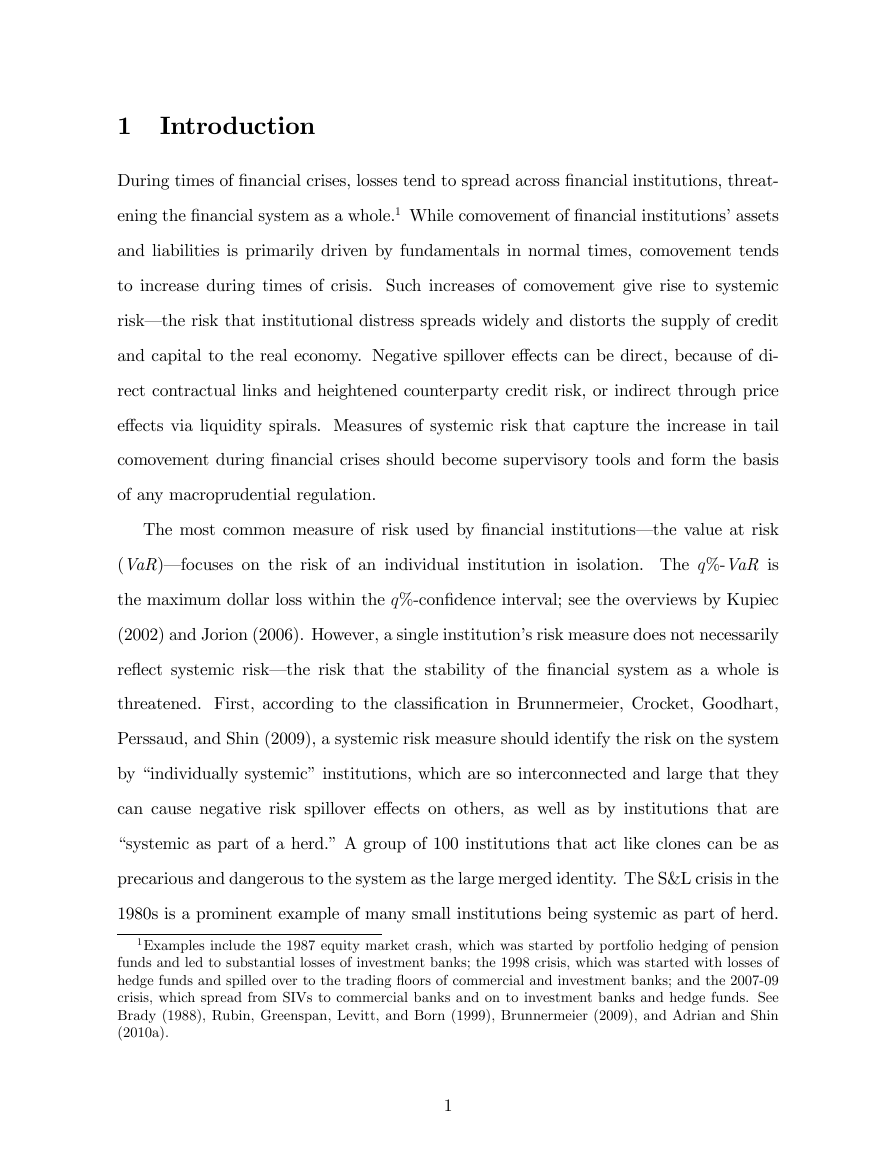


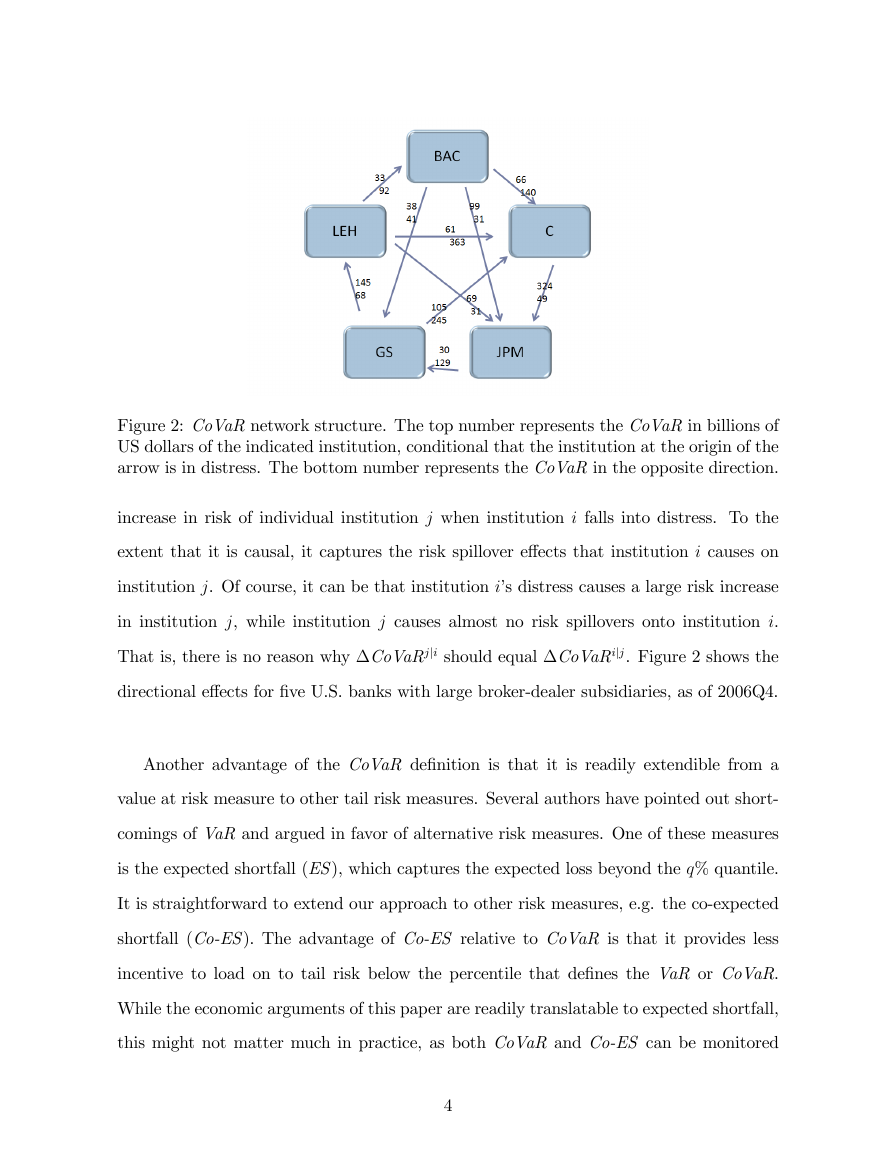
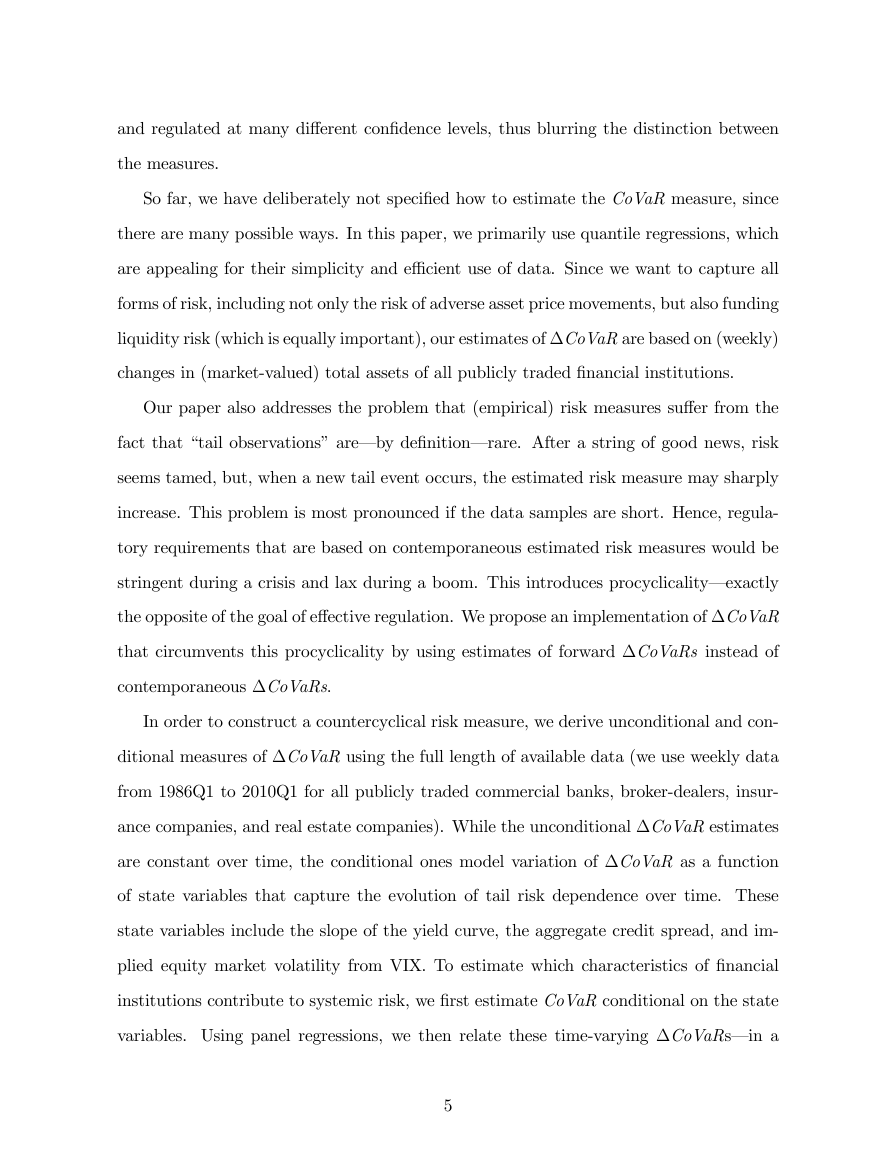
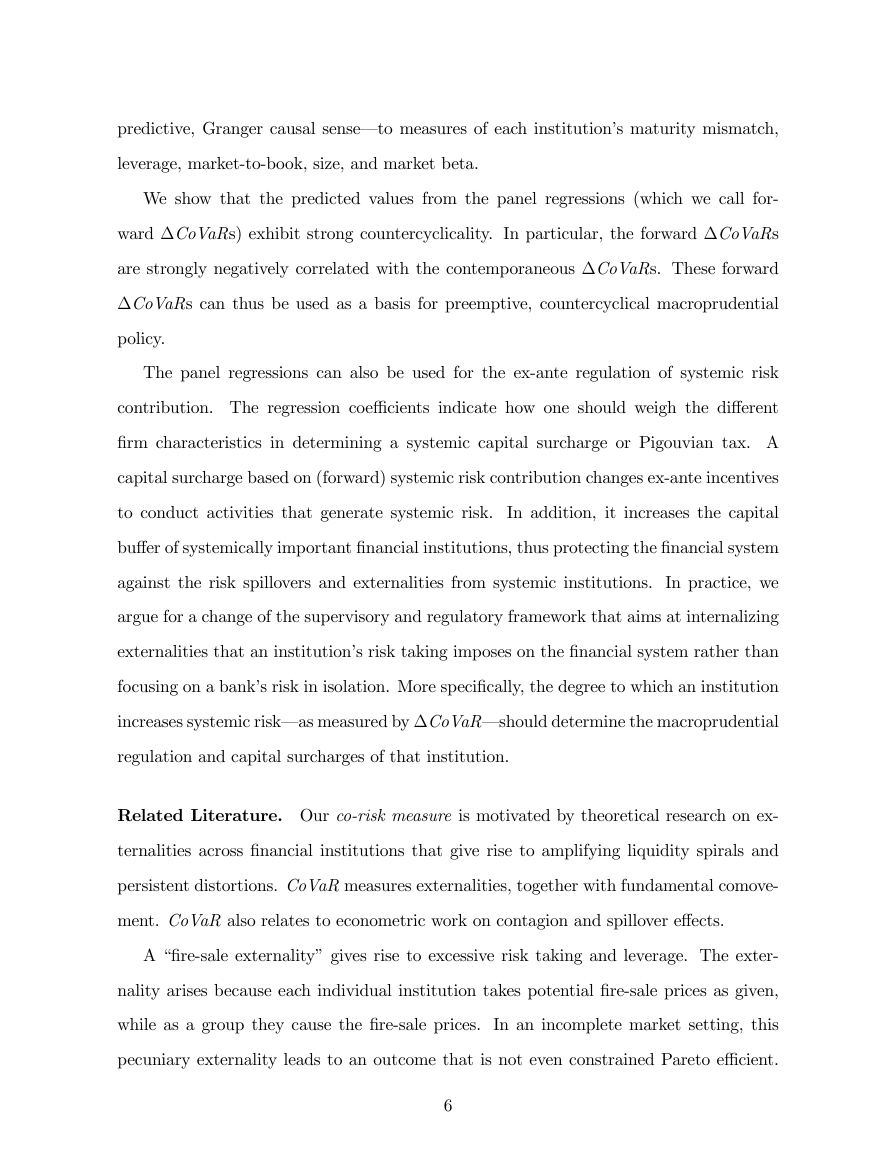
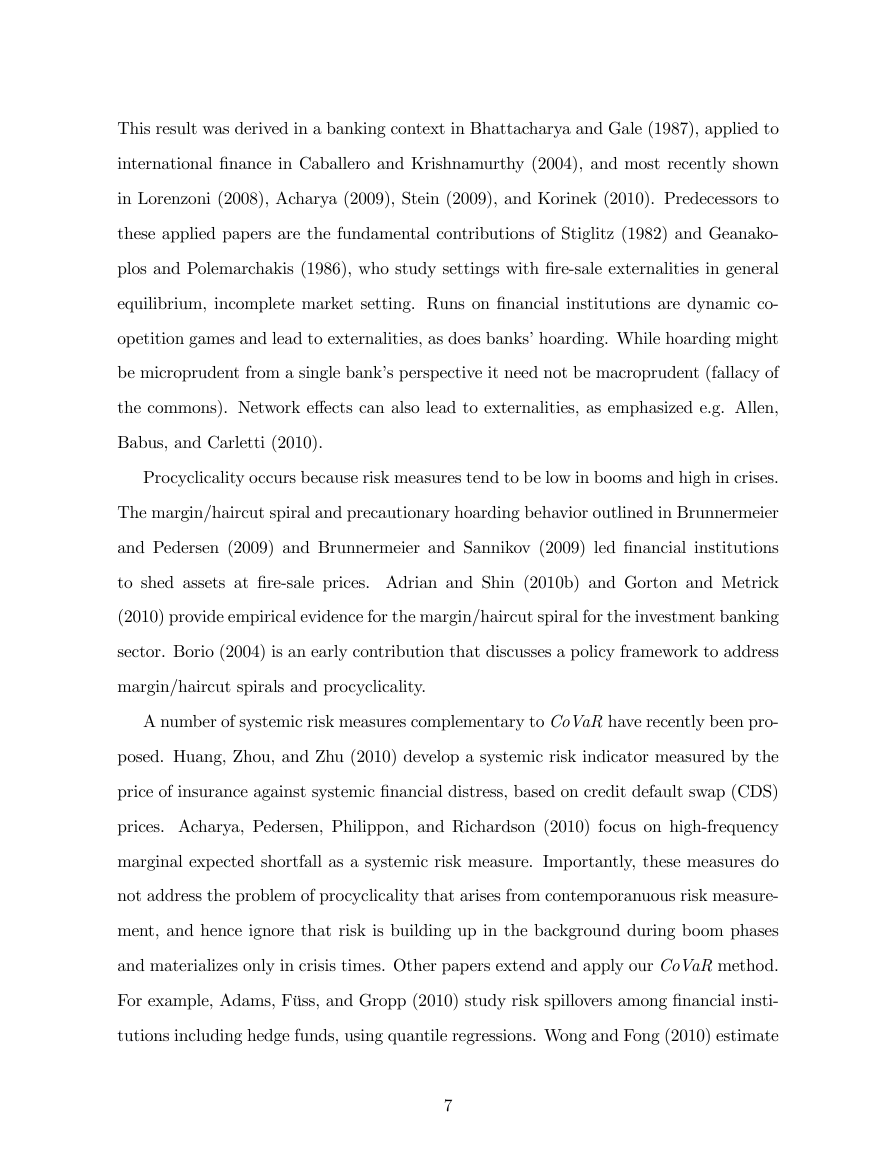








 2023年江西萍乡中考道德与法治真题及答案.doc
2023年江西萍乡中考道德与法治真题及答案.doc 2012年重庆南川中考生物真题及答案.doc
2012年重庆南川中考生物真题及答案.doc 2013年江西师范大学地理学综合及文艺理论基础考研真题.doc
2013年江西师范大学地理学综合及文艺理论基础考研真题.doc 2020年四川甘孜小升初语文真题及答案I卷.doc
2020年四川甘孜小升初语文真题及答案I卷.doc 2020年注册岩土工程师专业基础考试真题及答案.doc
2020年注册岩土工程师专业基础考试真题及答案.doc 2023-2024学年福建省厦门市九年级上学期数学月考试题及答案.doc
2023-2024学年福建省厦门市九年级上学期数学月考试题及答案.doc 2021-2022学年辽宁省沈阳市大东区九年级上学期语文期末试题及答案.doc
2021-2022学年辽宁省沈阳市大东区九年级上学期语文期末试题及答案.doc 2022-2023学年北京东城区初三第一学期物理期末试卷及答案.doc
2022-2023学年北京东城区初三第一学期物理期末试卷及答案.doc 2018上半年江西教师资格初中地理学科知识与教学能力真题及答案.doc
2018上半年江西教师资格初中地理学科知识与教学能力真题及答案.doc 2012年河北国家公务员申论考试真题及答案-省级.doc
2012年河北国家公务员申论考试真题及答案-省级.doc 2020-2021学年江苏省扬州市江都区邵樊片九年级上学期数学第一次质量检测试题及答案.doc
2020-2021学年江苏省扬州市江都区邵樊片九年级上学期数学第一次质量检测试题及答案.doc 2022下半年黑龙江教师资格证中学综合素质真题及答案.doc
2022下半年黑龙江教师资格证中学综合素质真题及答案.doc